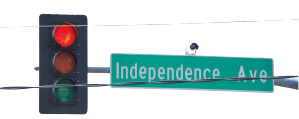
By LESLIE COLLINS
Northeast News
June 13, 2012
It’s been three years since Kansas City installed 29 red light cameras to modify driver behavior and reduce the number of crashes at intersections.
During the June 6 Public Safety and Emergency Services Committee meeting, Deputy Chief Cheryl Rose highlighted the success of the cameras.
“The red light cameras have reduced the number of crashes and injuries from running red lights,” she said.
Rose summarized the red light cameras report recently released by the Kansas City Police Department’s Special Operations Division. American Traffic Solutions, which operates the red light camera program, also contributed to the report.
Kansas City installed the cameras at 17 intersections and during the first year of installation, those intersections had a 65 percent drop in the number of vehicle accidents, compared to the year before the cameras were installed. Two years after the cameras were installed, KCPD reported a 54 percent decrease in the number of accidents. During both the first and second years of camera activation, the number of T-bone crashes were reduced.
As for issuing citations for running red lights, KCPD uses officers to review the camera footage, who issue citations at their own discretion. Sometimes violations are rejected due to weather related conditions, and other times a license plate may not be clear.
During the first year of camera activation (August 2009 to July 2010), KCPD issued 68,777 citations. By the second year (August 2010 to July 2011), the number of citations dropped to 45,793, a 33 percent decrease.
“That shows we are having an impact on driver behavior,” Committee member John Sharp said of the number of issued citations. “That’s significant. It does show it’s having the desired effect. People are being more careful and aren’t running as many red lights.”
Currently, Kansas City is considering moving three of the cameras to new locations and adding seven new locations, said City Engineer Gregory Rokos. American Traffic Solutions will conduct a traffic study to determine the most beneficial locations.
In addition to modifying driver behavior, the red light cameras have also provided an extra bonus. In at least 60 cases, KCPD has been able to use footage from the cameras to assist in investigations of robbery, car crashes and homicides, Rose said. KCPD is also using crash footage on its website to educate the public about intersection safety.
While Rose relayed the positives of using red light cameras, Eapen Thanpy, a Kansas City resident and member of the political action committee Keep Kansas City Free, wasn’t convinced.
Since both the KCPD and American Traffic Solutions contributed to the report, Thanpy said he didn’t think the report could be presented as “an objective, neutral analysis of data.”
“I think the public and certainly the people we represent are concerned about red light cameras from a number of fronts,” Thanpy told Northeast News.
Thanpy argued that red light cameras are set up to create additional revenue and can harm the relationship between the police department and citizens.
“Ultimately, revenue-based automated systems of law enforcement really corrode the relationship between people and government,” Thanpy said. “They (cameras) breed contempt for the law and make people suspicious that the government has been taken over by special interests that have special incentives.”
In addition, when it comes to red light cameras, people aren’t given due process, he said.
Thanpy also questioned the length of the yellow lights and said some dangerous intersections could be improved with a redesign.
“It’s important to understand that all of these cases are reviewed by an actual police officer before tickets are issued,” Sharp stressed. “And, people have a right to go to court to challenge the tickets and quite frequently do.”
Sharp added that he’s been affected by red light cameras firsthand.
“They’re (red light cameras) not popular with folks. I paid two of these tickets myself for my son when he was in college, but he learned his lesson,” Sharp said. “I understand nobody likes getting a ticket or paying a ticket, but T-bone crashes are some of the most dangerous crashes we have. I think the report makes it clear that cameras have made it safer to drive in Kansas City. It prevents crashes, it prevents injuries and it prevents fatalities.”

















